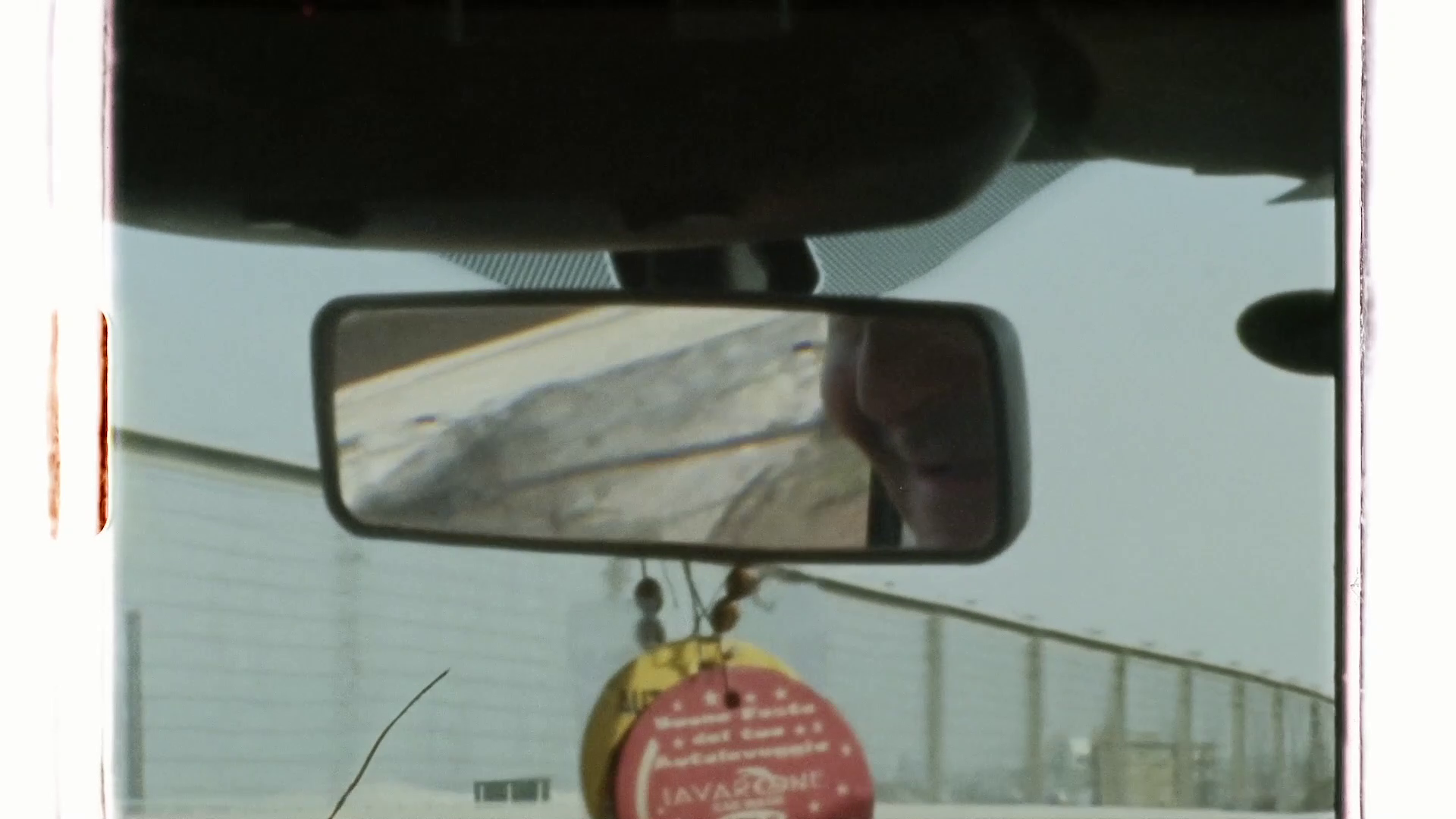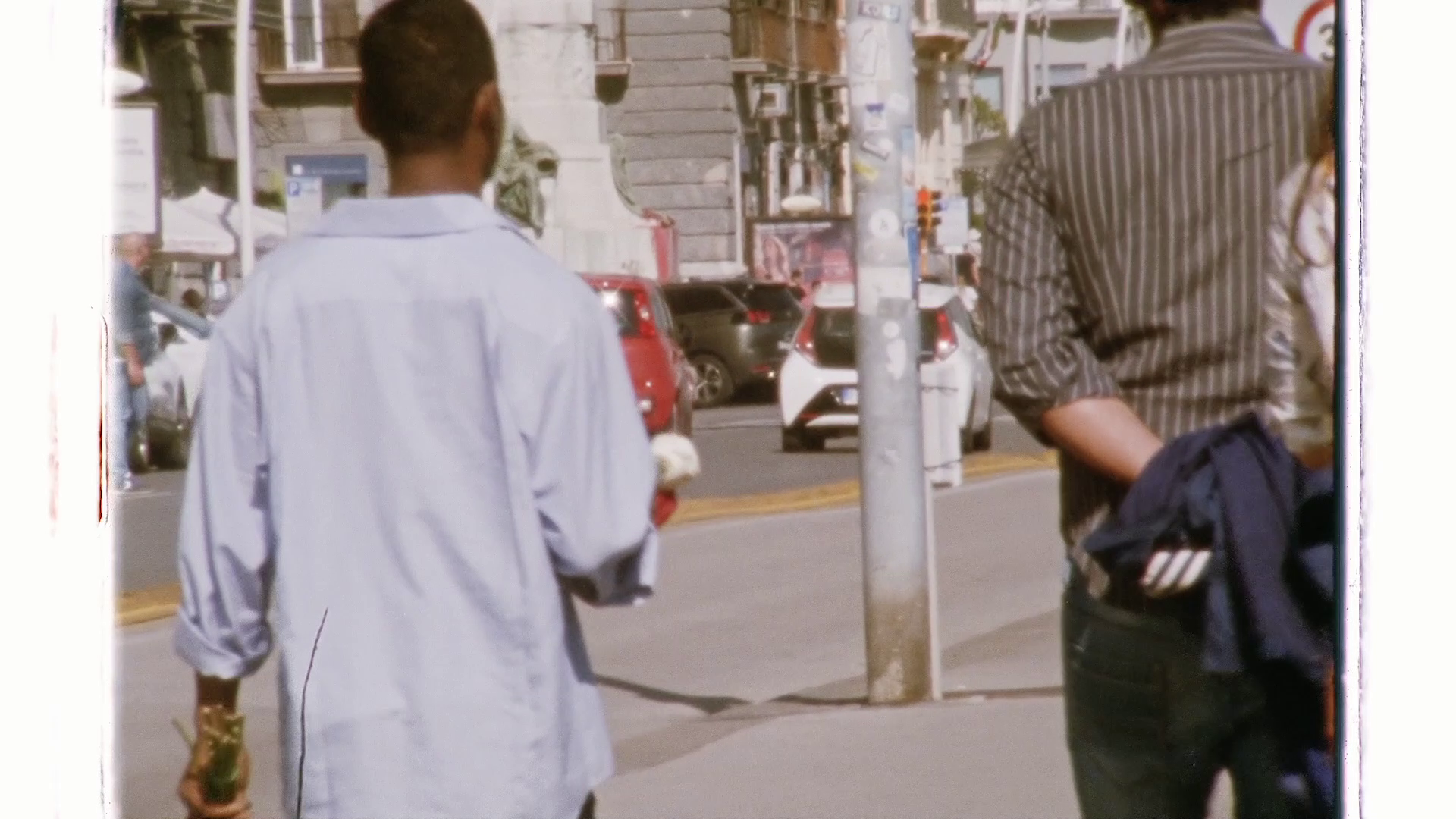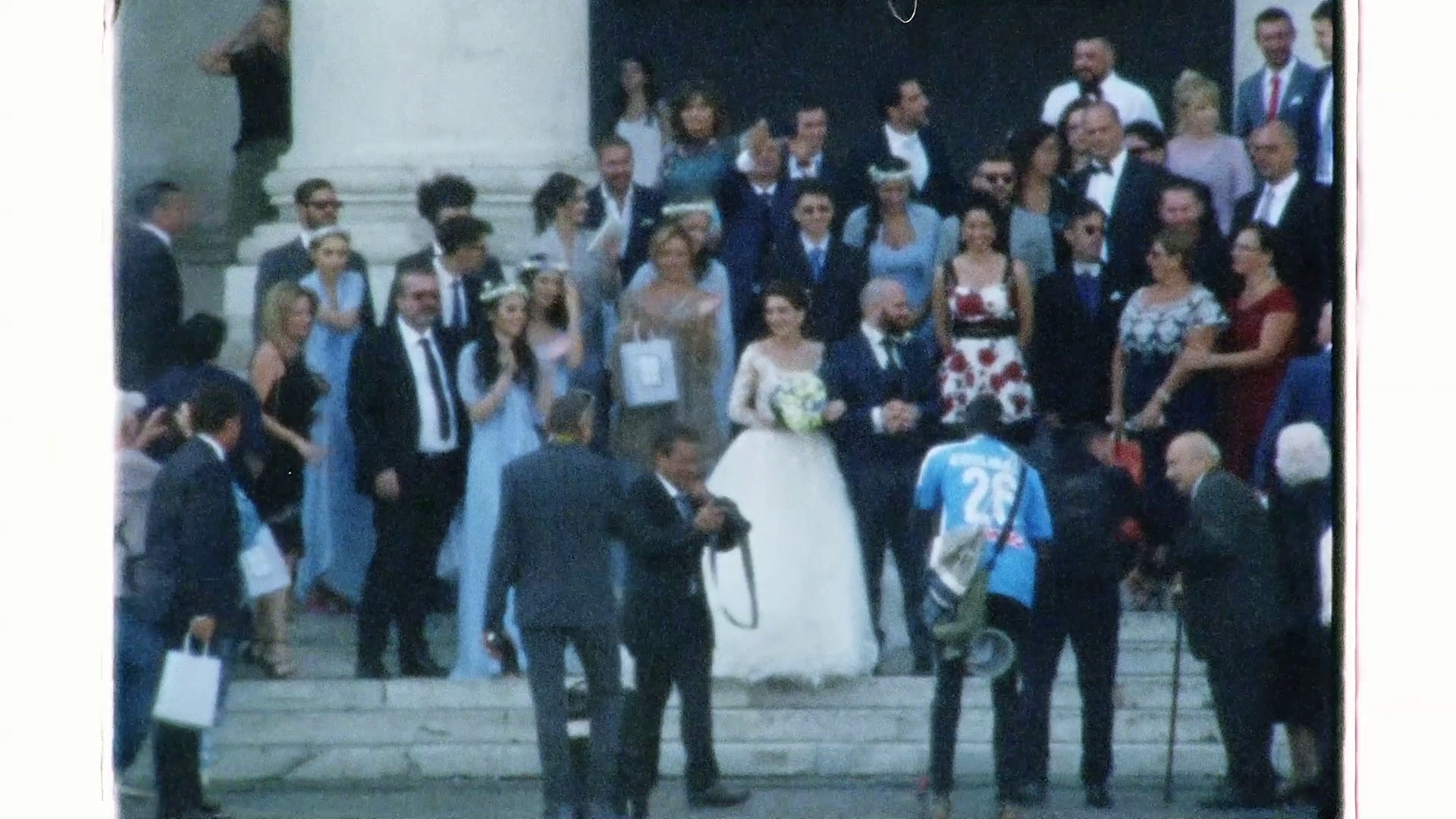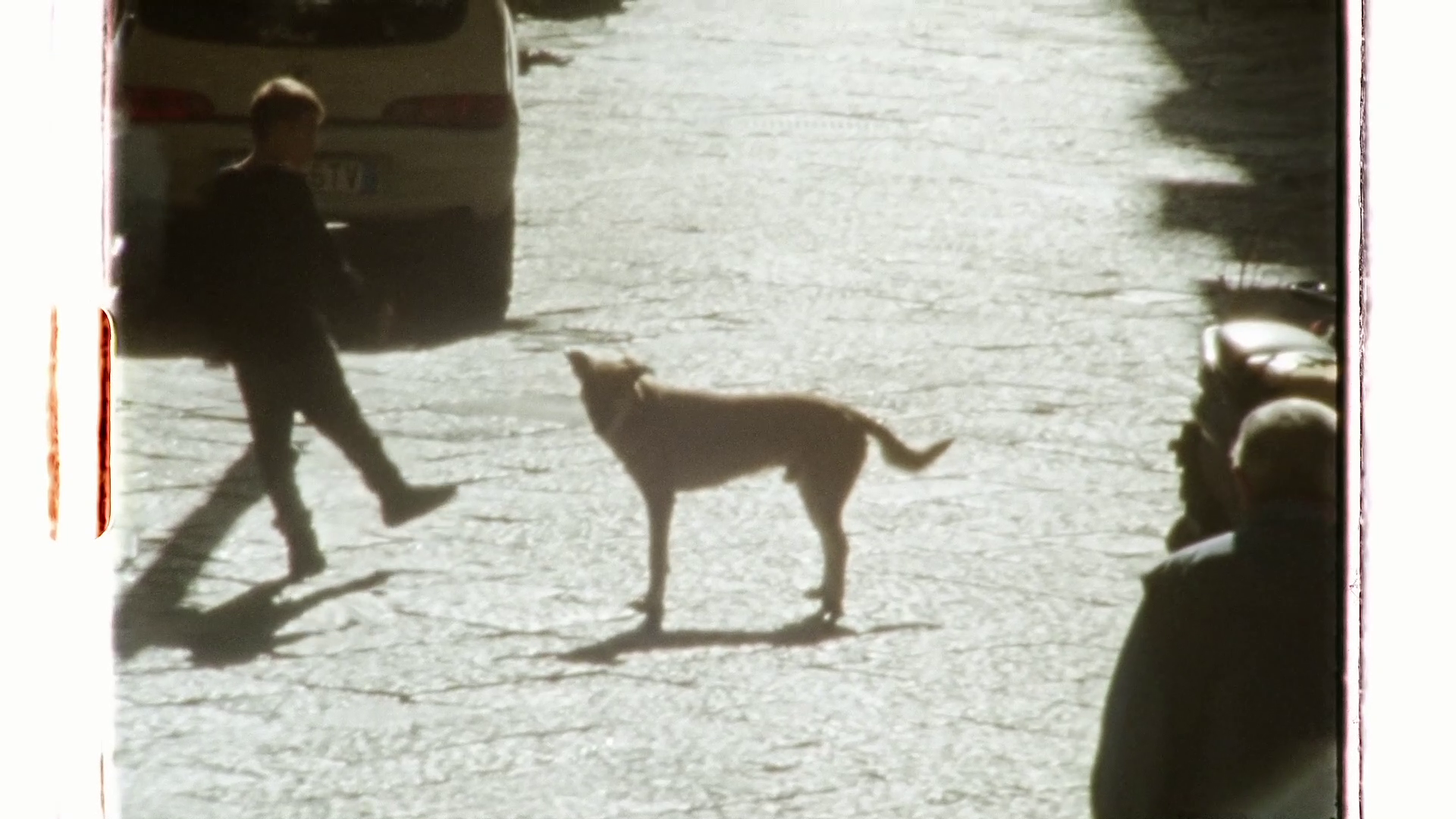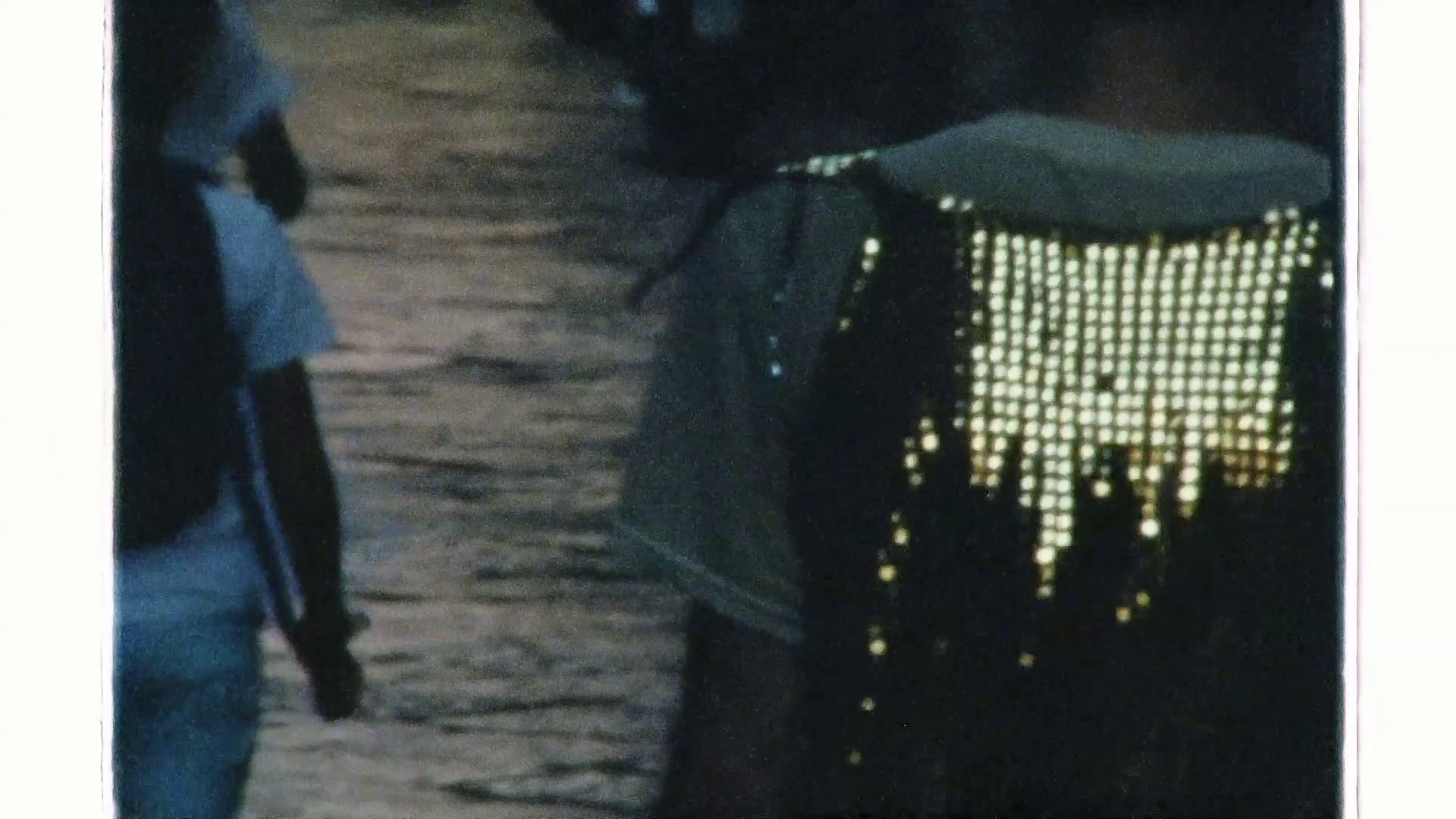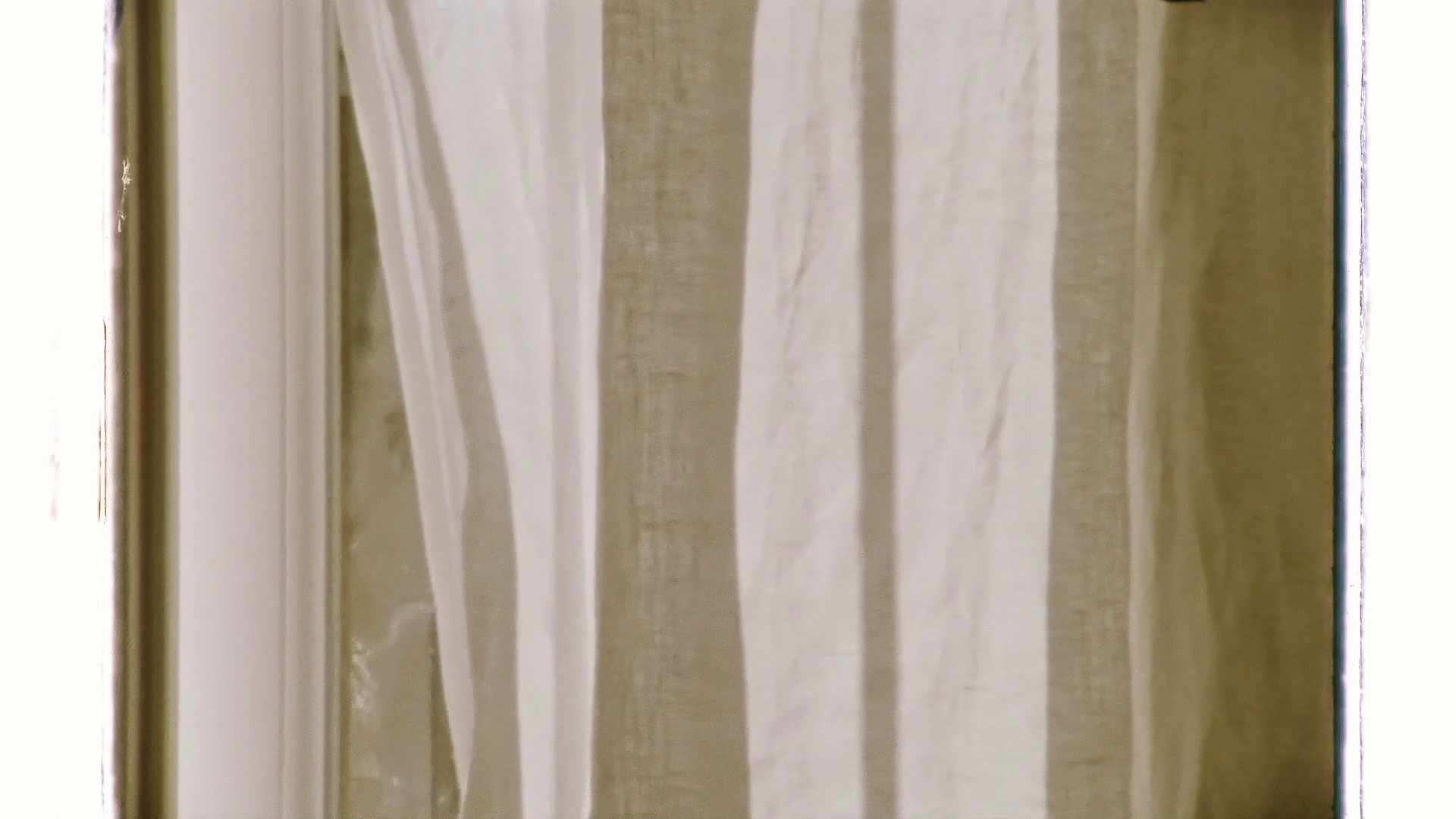NAPULE, 8mm Film, colour/black white, Duration:8:00 min, 2019-2020
Music+Sound Editing: Katharina Kast @dememorize_music
Film Editing: Claudia Siefen-Leitich
Consultant: Christian Leitich
Music Mixing: Leon Leder @aaasfast
Picture Editing: Paul Krimmer @tonkino_saalbau
Speaker: Lorenzo Xiques @lorenzoxiques
Trailer by Igor Basagic
NAPULE
Ein Film von Kevin A. Rausch
von Claudia Siefen-Leitich
„Wie geht es dir meine Liebe,
ich denke an dich
Schickt mir ein Foto von dir
In einigen Tagen schicke ich dir das Paket mit der Kleidung.
Antworte mir wie es dem Kind geht
Ciao Aldo“
(Carlo im Gefängnis)
„Ich warte auf Arbeit, Wohnung habe ich schon“
— Geht man davon aus, dass das Verstörende, das Sinnesfrohe und das Illusionistisch-Effektvolle die Hauptmerkmale von Rausch’s Malerei sind, ist es nicht schwer, diesen Film als barock einzustufen. Denn zahlreiche Charakteristika lassen sich hier geradezu dem Barock zuordnen. Rausch nimmt uns an die Hand und führt uns fast selbstvergessen in sein „Arcadia“. Zum einen wäre das Stilmittel des Kontrastes zu nennen. Durch die Gegenüberstellung der beleuchteten und mit reinen Farben versehenen Figuren mit der sanften, mischtönigen und unspezifisch-idealisierten Städtelandschaft von Neapel, entsteht eine eigentümliche Spannung, so harmonisch das Bild auch im ersten Moment auf den Betrachter wirken mag.
Rausch zeigt einen anderen Sehnsuchtsort, er differenziert die klassische Italienreise zur individuellen, sensualistischen Italienreise: sein Arcadia ist eingebettet in Neapel. Und gibt somit einen normativ kritischen Blick der frühen Aufklärer auf, um gar ein ästhetisiertes Italienbild zu schaffen. Seine gegenständliche Wahrnehmung, also dem selbsterlebten Erwerb und vielleicht auch die Verarbeitung von Fakten und Wissen, erscheinen durch eine innengeleitete Zweckbestimmung ergänzt und vertieft. Es ergibt sich eine kratzige, verwischte und gleichsam harmonische Übereinstimmung von Kunst und Leben. Rausch flieht hier vor den Zwängen der Heimat. Das Schlagwort von der »geistigen Wiedergeburt« durchzieht somit den Fluss des Films.
Das Geistige im Körperlichen ausmachend, wühlende Hände, im Himmel strampelnde Beine, ein Mann am Wasser sitzend, den Blick über die rechte Schulter gewendet. Dieser gemahnt gar an „Aufbruch der Fischer“ von Hans von Marées, wo die großen Flächen des Strandes, der Felsen und des Himmels für sich gesehen als geradezu ungegenständliche Kompositionen über die Themen Dunkelbraun, Hellbraun, Ocker, Violett, Olivgrün, Blau, Grau und Weiß erscheinen, gebildet aus abstrakt wirkenden Strukturen aus Farben, Formen und Richtungen. Die Wassertropfen auf dem Rücken, das Glitzern des Wassers. Warum blickt unser Fischer sich um? Es sind Fels und Vegetation, die hier bei Rausch auch malerisch und verwischt mit seiner Kamera wiedergegeben werden. Als Fels, Meer, Strand und auch Himmel durchaus klar erkennbar, werden diese durchstrukturierten Flächen erst durch einzelne konkrete Elemente wie Bäume, Häuser, und auch Fahrzeuge als persönliche Erfahrung und somit auch als ein Wissen, gar als menschliche Anatomie zusammengesetzt und somit greifbar.
Und wie mag das klingen? Die engen Gassen, das Getümmel, und erst nach und nach wird die Struktur der Stadt ersichtlich, welche durch Straßen und Gassen gegliedert wird. Ein klar definiertes Straßennetz sucht man hier vergeblich. Es scheint keinen Unterschied zu geben zwischen Fahrbahnen und Gehsteigen, doch gelegentlich weiten sich diese engen, kaum mehr als vier Meter breiten Gassen und man steht plötzlich vor einer Kirche. Diese ist vorher nicht zu sehen, ganz anders als in den meisten Städten, wo man bereits von weitem einen Kirchturm erblickt und sich somit zurechtfinden kann. Man sieht gerade einmal die engen Schluchten der Straßen, man schwenkt den Blick nach oben, und es erscheint doch nur ein Lichtstreifen, der zwischen den fünf- oder sechsgeschossigen Gebäuden zu einem durchdringt.
Mit Geige, Stimme und Effektgeräten destilliert die Komponistin Katharina Kast gleichsam die eingefangenen Bilder. Ein unruhiges, tägliches Flanieren von über vier Wochen, jeden Tag 3 bis 4 Stunden durch die Straßen und Gassen der inneren Stadtteile von Napoli. Mit Kamera und Tonaufnahmegerät sucht Rausch explizit, spricht mit Passanten, aber auch zielgerichtet, etwa mit dem Mann aus dem Typografieladen. In der Montage und der Toncollage werden Bild und Ton getrennt, um anderweitig wieder zueinander zu finden.
Der Ton kreiert ein weiteres Bild, welches eine neue Geschichte erzählt. Fußball spielende Kinder und das Geschwisterpaar im Spanischen Viertel erzeugen ein Gefühl von Vertrautheit, welche über den Ton wieder aufgelöst wird. Stimmen von Passanten, Schritte und Stadtgeräusche auf der Largo Regina Coeli. Der Marionettenspieler auf der San Sebastiano und die Zugstation Montesanto wiederum geben ein Gefühl des Dirigierens, der Weg ist schon gewiesen, ob man ihn geht ist eine immer wieder zu stellende Frage.
Das Meeresrauschen und die Schreie der Vögel während eines Ausfluges zur Insel Procida bringen hingegen wieder eine Freiheit und Lockerheit in die gesamte Komposition, welche ein kurzes Schwanken verursacht. Nicht unangenehm, die Altstadt Portanapoli bietet durchaus ein Korsett, um wieder Festigkeit in die Schritte und somit auch in die von Rausch geführte Kamera zu bringen. Die Original-Tonaufnahmen ziehen sich bis hin zum Abspann, der dort gestaltete akustische Raum stammt aus einem Stiegenhaus eines ungenutzten Wohngebäudes auf Procida neben dem dortigen Gefängnis.
Die von Lorenzo Xiques gesprochenen Zeilen sind Briefzitate, sehnsuchtsvolle einfache Worte aus einer Gefängniszelle, manchmal auf eine Postkarte geschrieben. Doch zu wem spricht er? In der Zusammenführung mit der Montage könnten wir es auch selbst sein, in den Spiegel schauend, es fehlen uns nur die Postkarten in den Händen. Mit der Stimme öffnet sich der Raum, die Enge muss in uns selbst liegen. Und auch die Zärtlichkeit.—
„Noch arbeite ich nicht,
in 8 Tagen erwarte ich eine sichere Antwort,
sobald ich jedoch anfange zu arbeiten, schicke ich dir etwas Stoff.
Antworte mir bald.
Ich hab dich so lieb und ich sehne mich nach dir!
Aldo“
(Aldo Lupoletti Spital S. Spirito Medicina Sociale Pescara)
NAPULE
A film by Kevin A. Rausch
(Claudia Siefen-Leitich, geboren 1972 in Köln. - Autorin, Herausgeberin und Filmemacherin. Schreibend & unterrichtend zu Filmtheorie, Japanische Avantgarde, und Analogfilm.)
„How are you my love,
I am thinking of you
Send me a picture of you
In a few days I will send you the package with the clothes.
Answer me how the child is doing
Ciao Aldo“
(Carlo in prison)
„I’m waiting for work, I already have an apartment“
— Assuming that the disturbing, the sensual and the illusionistic are the main characteristics of Rausch's painting, it is not difficult to classify this film as baroque. For numerous characteristics can be classified as baroque. Rausch takes us by the hand and leads us almost self-forgetting into his "Arcadia". On the one hand, the stylistic device of contrast is to be mentioned. The juxtaposition of the illuminated and pure-coloured figures with the gentle, mixed and unspecific, idealised urban landscape of Naples creates a peculiar tension, however harmonious the picture may appear to the viewer at first glance.
Rausch shows a different place of longing, he differentiates the classic Italian journey from the individual, sensualistic Italian journey: his Arcadia is embedded in Naples. And thus gives up a normatively critical view of the early Enlightenment to even create an aestheticised image of Italy. His representational perception, i.e. the self-experienced acquisition and perhaps also the processing of facts and knowledge, appears to be supplemented and deepened by an internally guided purpose. The result is a scratchy, blurred and at the same time harmonious correspondence between art and life. Rausch flees here from the constraints of home. The catchword of "spiritual rebirth" thus runs through the flow of the film.
Establishing the spiritual in the physical, digging hands, legs kicking in the sky, a man sitting by the water, looking over his right shoulder. This is reminiscent of Hans von Marées' “Departure of the Fishermen”, where the large areas of the beach, the rocks and the sky, seen in isolation, are almost non-representational compositions on the themes of dark brown, light brown, ocher, violet, olive green, blue, gray and Appear white, formed from abstract structures of colors, shapes and directions. The drops of water on your back, the glitter of the water. Why is our fisherman looking around? Rock and vegetation are reproduced here by Rausch in a picturesque and blurred manner with his camera. Clearly recognizable as rock, sea, beach and also sky, these structured surfaces are only put together and thus tangible through individual concrete elements such as trees, houses and vehicles as a personal experience and thus also as a knowledge, even as human anatomy.
And how might that sound like? The narrow streets, the hustle and bustle, and only gradually does the structure of the city become apparent, which is divided by streets and alleys. One looks in vain for a clearly defined street network here. There seems to be no difference between pavements and pavements, but occasionally these narrow alleys, barely more than four metres wide, widen and you suddenly find yourself standing in front of a church. This is not visible before, unlike in most towns where you can see a church tower from afar and thus find your way around. You can barely see the narrow gorges of the streets, you swing your gaze upwards, and yet only a strip of light appears, which penetrates between the five or six-storey buildings.
The composer Katharina Kast distils the captured images with violin, voice and effect devices. A restless, daily stroll of over four weeks, every day 3 - 4 hours through the streets and alleys of the inner districts of Naples. With camera and sound recorder Rausch searches explicitly, talks to passers-by, but also in a targeted manner, for example with the man from the typography shop. In the montage and the sound collage, image and sound are separated in order to find each other again elsewhere.
The sound creates another image that tells a new story. Children playing football and the siblings in the Spanish Quarter create a feeling of familiarity, which is dissolved again by the sound. Voices of passers-by, footsteps and city noises on Largo Regina Coeli. The puppeteer on the San Sebastiano and the train station Montesanto in turn give a feeling of conducting, the way is already shown, whether one walks it is a question to be asked again and again.
The sound of the sea and the cries of birds during a trip to the island of Procida, on the other hand, bring back a freedom and looseness to the whole composition, causing it to sway briefly. Not unpleasant, the old town of Portanapoli certainly offers a corset to bring back firmness in the steps and thus also in the camera, which is guided by intoxication. The original sound recordings stretch all the way to the credits, the acoustic space created there comes from a staircase of an unused residential building on Procida next to the prison there.
The lines spoken by Lorenzo Xiques are quotes from letters, wistful simple words from a prison cell, sometimes written on a postcard. But to whom does he speak? In combination with the montage, it could also be us, looking in the mirror, only the postcards in our hands are missing. With the voice the space opens up, the narrowness must be within ourselves. And also the tenderness. —
„I’m not working yet,
in 8 days I expect a safe answer,
however, as soon as I start working, I will send you some weed.
Answer me soon.
I love you so much and I am longing for you!
Aldo“
(Aldo Lupoletti Spital S. Spirito Medicina Sociale Pescara)
(Claudia Siefen-Leitich, born 1972 in Cologne. - Author, editor and filmmaker. Writing & teaching on film theory, Japanese avant-garde, and analogue film).


